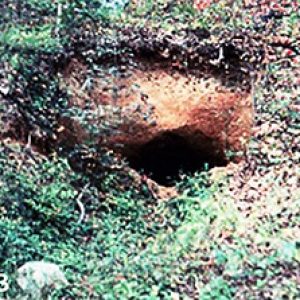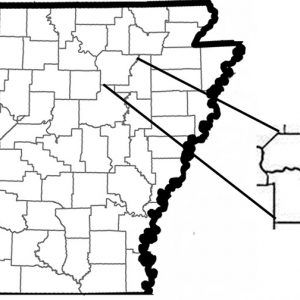calsfoundation@cals.org
Gold Mine Springs Mines
Abandoned mines play an important ecological role as temporary or permanent habitats for various biota. Many of these mines were merely short shafts dug out of the earth during a search for precious minerals or metals, whereas others became lengthy. Moreover, abandoned mines represent unique ecological resources for both invertebrates and vertebrates that utilize the mines on a permanent or temporary basis as sites for breeding, hibernating, feeding, or avoiding predators. In Arkansas, most of these abandoned mines are located within the uplands, especially the Ouachita Mountains, but some are within the Ozark Mountains. For instance, there were numerous abandoned lead and zinc mines scattered about much of the Arkansas Ozarks. Some communities were even named after the mines, such as Zinc and Lead Hill in Boone County. Marion County is another area especially rich with mines, most notably the ghost town of Rush. Many of these mines represent straight or “L-shaped” shafts extending from about fifty to five hundred feet. In addition, the temperature in these mines is similar to that of caves and averages between 46.4 and 61.8°F. Most importantly, by means of springs or rainfall seepage, several mines contain permanent pools or streams with variable amounts of leaf litter near their outflows that provide key microhabitats.
One such group of Ozark mines, locally known as Gold Mine Springs Mines, was located in Independence County, about 7.5 miles northwest of Possum Grape (Jackson County). This locale is within the eastern limit of the Ozark Mountains (easternmost extent of Boston Mountains) near the boundary of the Mississippi River Alluvial Plain. It is unknown why these mines were originally drilled, but lead, manganese, and zinc mining was being conducted in the county as early as the 1850s.
The location included three abandoned mines, with one having a flowing spring-fed water source with various pools. These mines were the location of several important biological surveys of vertebrates conducted in the 1990s. One study, published in 1995, listed sixteen vertebrate species found within the mines, including two species of troglophilic (able to live their entire life in mine) salamanders, six species of accidental (species that wander into a cave but cannot live there) or trogloxene (mine guests that periodically live there) frogs and toads, two accidental lizards, one trogloxene snake, one accidental bird, three trogloxene bats, and an accidental mouse. At the same time, tracks of larger mammals were seen within the mines, including coyotes, Virginia opossums, raccoons, and striped skunks. It was obvious that these mammals frequented or accidentally wandered into the mines, likely in search of water or food.
Other scientific studies conducted with specimens from this mine include two surveys on the parasites of the pickerel frog, published in 1995 and 1996, and coccidian parasites from a five-lined skink collected just outside Mine Shaft No. 1, published in 1995.
Unfortunately for scientists, the mine shafts no longer exist. In 2002, a group of three local boys (ages nine, eleven, and nineteen) wandered into one of the mines with their dog, looking for gold. Five minutes into their trek, the ground moved and the dirt ceiling collapsed, trapping them in a pocket. A wall of mud about 100 feet tall beyond the mine’s entranceway blocked their escape, and they got lost in the crawl space 200 feet underground for a day and a half. Rescuers heard tapping sounds from the trapped boys and crawled to reach the three by digging with their hands and small shovels at about a foot an hour. Once extracted, the dehydrated and scared boys were found to be unhurt. As a result of this incident, the landowner and state personnel decided to seal the mine shafts using dynamite.
For additional information:
Barr, Thomas C. “Ecological Classification of Cavernicoles.” Cave Notes 5 (1963): 9‒12.
Branner, John C. Annual Report of the Geological Survey of Arkansas for 1892. Vol. 5, The Zinc and Lead Region of North Arkansas. Little Rock: Thompson Lith. and Ptg. Co., 1900.
Dorris, Peggy R., and David A. Saugey. “Spiders Collected from Abandoned Mine Tunnels in the Ouachita National Forest.” Proceedings of the Arkansas Academy of Science 37 (1983). Online at https://scholarworks.uark.edu/jaas/vol37/iss1/26 (accessed June 25, 2019).
Heath, Darrell R., David A. Saugey, and Gary A. Heidt. “Abandoned Mine Fauna of the Ouachita Mountains, Arkansas: Vertebrate Taxa.” Proceedings of the Arkansas Academy of Science 37 (1983): 80. Online at https://scholarworks.uark.edu/jaas/vol40/iss1/12/ (accessed June 25, 2019).
Howard, J. Michael. “Rush Creek Mining District, Marion County, Arkansas: A Synoptic View.” Rocks and Minerals (July/August 1989): 284–292.
McAllister, Chris T., Charles R. Bursey, and Stanley E. Trauth. “Parasites of the Pickerel Frog, Rana palustris (Anura: Ranidae), From the Southern Part of its Range.” Southwestern Naturalist 40 (1995): 111‒116.
McAllister, Chris T., and Stanley E. Trauth. “Ultrastructure of Cepedietta virginiensis (Protista: Haptophrynidae), from the Gall Bladder of the Pickerel Frog, Rana palustris, in Arkansas.” Journal of the Arkansas Academy of Science 50 (1996): 133‒136. Online at https://scholarworks.uark.edu/jaas/vol50/iss1/27 (accessed June 25, 2019).
McAllister, Chris T., Stanley E. Trauth, and Linda D. Gage. “Vertebrate Fauna of Abandoned Mines at Gold Mine Springs, Independence County, Arkansas.” Proceedings of the Arkansas Academy of Science 49 (1995): 184‒187. Online at https://scholarworks.uark.edu/jaas/vol49/iss1/40/ (accessed June 25, 2019).
McAllister, Chris T., Steve J. Upton, and Stanley E. Trauth. “New Host and Distributional Records for Coccidia (Apicomplexa: Eimeriidae) from North American Lizards (Reptilia: Sauria).” Journal of the Helminthological Society of Washington 61 (1994): 221–224.
McKnight, E. T. Zinc and Lead Deposits of Northern Arkansas. U.S. Department of the Interior, Bulletin 853. Washington, D.C.: U.S. Government Printing Office, 1935.
Saugey, David A., Darrell R. Heath, and Gary A. Heidt. “Bats of the Ouachita Mountains.” Proceedings of the Arkansas Academy of Science 43 (1989): 71‒77. Online at https://scholarworks.uark.edu/jaas/vol43/iss1/22 (accessed June 25, 2019).
———. “Summer Use of Abandoned Mines by the Caddo Mountain Salamander, Plethodon caddoensis (Plethodontidae) in Arkansas.” Southwestern Naturalist 30 (1985): 318‒319.
Slay, Michael E., and Charles J. Bitting. Is a Mine a Terrible Thing to Waste? Additional Subterranean Habitats for Troglobitic Fauna and Other Cavernicoles in the Ozarks. In Proceedings of the 18th National Cave and Karst Management Symposium, edited by William R. Elliott. Nashville, TN: Greyhound Press, 2007.
Upton, Steve J., Chris T. McAllister, and Stanley E. Trauth. “Two New Species of Coccidia (Apicomplexa: Eimeriidae) from Eumeces fasciatus (Sauria: Scincidae) in Arkansas.” Canadian Journal of Zoology 69 (1991): 2028‒2030.
“Three Boys Rescued from Civil War-Era Mine in Arkansas.” Arizona Daily Sun, April 9, 2002. Online at https://azdailysun.com/boys-rescued-from-civil-war-era-mine-in-arkansas/article_5a6c09e6-48c4-5b2c-860e-139a99cedd42.html (accessed June 25, 2019).
Chris T. McAllister
Eastern Oklahoma State College
Stanley E. Trauth, Emeritus
Arkansas State University
 Gold Mine Springs Mines
Gold Mine Springs Mines  Gold Mine Springs Mines Location
Gold Mine Springs Mines Location 



Comments
No comments on this entry yet.